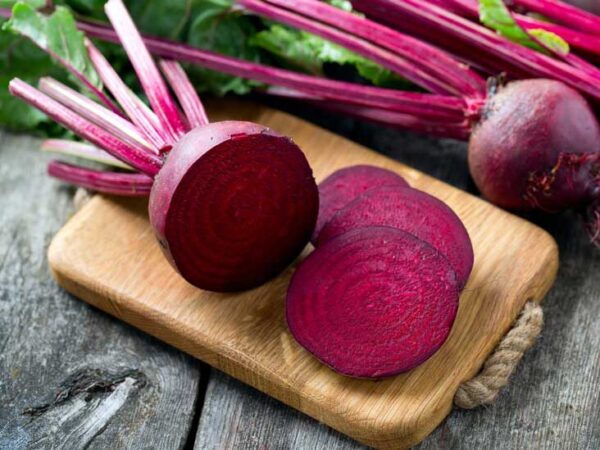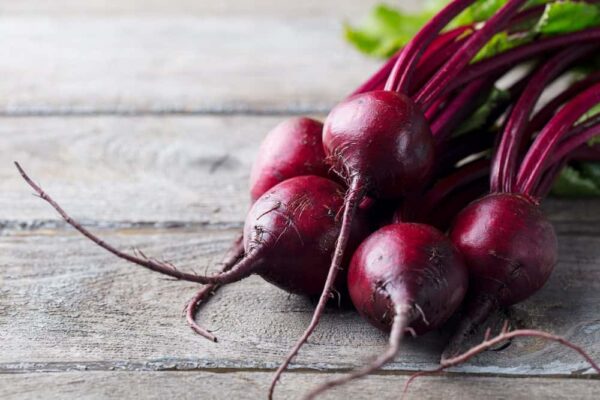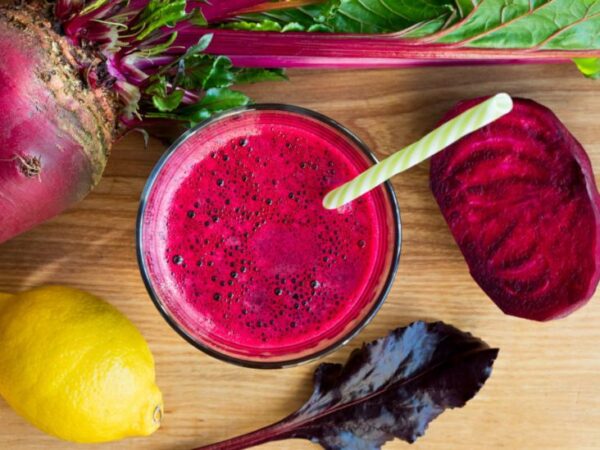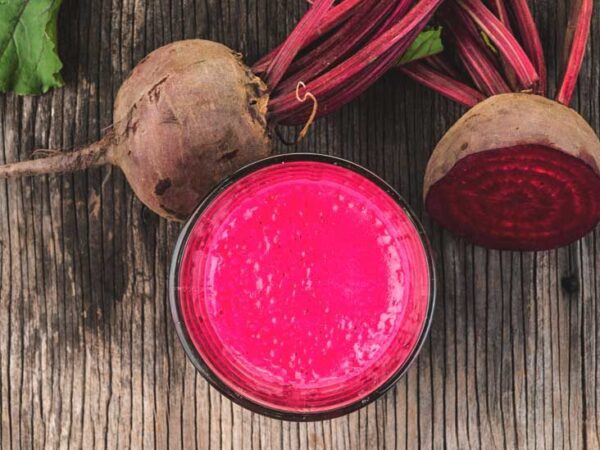If you are a lover of vegetables, especially beets, I invite you to continue reading to learn about its main characteristics, the types of beets that exist, nutritional properties, health benefits, consumption options, as well as frequently asked questions related to its cultivation and storage.
What is Beetroot?

Beets, also known as beets, are edible root tubers native to North Africa, Asia, and Europe.
It is a very nutritious food, used in salads, soups, pickles, creams, snacks, and desserts. The most common variety of beets is red-purple and medium-sized. However, there are beets in many colors, including gold, pink, red, white, and striped. Its diameter can vary from the size of radish to that of an extra-large potato.
Beets have a sweet and earthy flavor, reminiscent of the taste of corn. In addition to their use in food, they are an important source of sucrose. Hence they are used to make refined sugar in several countries around the world.
Characteristics and data of interest
- Beets have been cultivated for more than 4,000 years (2,000 BC) in the Mediterranean region.
- The plant is edible in its entirety, from the leaves to the root.
- In ancient times, Beetroot was not used to treat common pain, such as headaches and toothaches.
- Currently, it is a very versatile product that is used as food. It also serves as a raw material to make sugar and as food for animals.
- The world’s largest beet was grown in the UK in 2001 and weighed more than 51 pounds.
- Several studies have shown that the high levels of antioxidants and unique anti-inflammatory agents found in beets contribute to the prevention of many types of cancer.
Types of beetroot

Not all beets are red-purple in color; There are varieties of different sizes and colors, including yellow and even stunning striped ones. Find out below the main characteristics of the most popular types of beets:
- Red or purple beets. These are the most common beets. They have a sweet-earthy flavor, and their most special characteristic is their intense wine-red color. They can be used in many ways in the kitchen, whether as an ingredient in salads, stews, soups, sauteed vegetables, vegetable creams, etc.
- Golden beets. Golden beets are less sweet than red beets; their flavor is milder, less earthy, but they are still an excellent option to add a touch of color to our meals and salads.
- Striped beetroot. Striped or Chioggia beets are naturally striped; some have a subtle combination of yellow with orange, while others sport bright yellow, red, and cream hues. They are used like any other beet, and unfortunately, the streaks often fade or even disappear during cooking.
- Baby beets. Any beet can be a “baby beet,” as these are beets harvested from the field ahead of time. The tender leaves and stems make them a widespread addiction to fresh vegetable salads.
- Sugar beet: Sugar beet or sugar beet looks more like a turnip than a beet. Its color is whitish, and it has a conical structure. These tubers are generally only grown commercially for sugar production; about 20% of world sugar production comes from sugar beets, and the other 80% comes from sugar cane.
Nutritional properties of beetroot
Beets are a highly nutritious root vegetable. They are an excellent source of vitamins (vitamin C, B vitamins) and minerals (folic acid, manganese, iron, phosphorus, copper, and potassium).
They are also rich in antioxidants and phytochemicals such as anthocyanins, carotenoids, lutein/zeaxanthin, glycine, and betaine. They are rich in dietary fiber, low in fat, cholesterol, and calories, yet they have the highest sugar content of all vegetables, so they are relatively high in carbohydrates.
Nutritional information for beets (1 cup or 136 g):
- Calories: 59
- Grease: 0.2 g
- Cholesterol: 0 mg
- Sodio: 106 mg (4%)
- Potassium: 442 mg (12%)
- Phosphorus: 45 mg
- Carbohydrates: 13 g (4%)
- Dietary fiber: 3.8 g (15%)
- Azúcar: 9 g
- Protein: 2.2 g (4%)
- Vitamina A: 45 IU
- Vitamin C: 11%
- Calcium: 2%
- Iron: 6%
- Vitamin B-6: 5%
- Magnesium: 7%
What is beetroot good for? Benefits and uses

The health benefits of beets include:
- Helps lower blood pressure: beetroot is abundant in potassium and certain nitrates that have the property of converting into nitric oxide once they enter the body. Nitric oxide and potassium help relax and dilate blood vessels, which lowers blood pressure and prevents hypertension. A study by the American Heart Association showed that people with high blood pressure could see a significant drop in their systolic blood pressure if they drank 250 ml of beet juice daily as part of their diet.1
- Promotes liver detoxification. The betaines present in beets stimulate liver functions, while pectin (water-soluble fiber) helps remove toxins from the liver. According to this study2, regular consumption of beets helps heal liver diseases and can reverse fatty liver.
- Prevents anemia. Red beets have a significant amount of iron, which helps prevent anemia and increases the regeneration of red blood cells. In addition, its contribution to vitamin C favors the absorption of this iron in the body. Without a doubt, it is a vegetable to include in your diet.
- Helps prevent cancer. Some investigations3 have revealed that beets are good for preventing skin, lung and colon cancer as it contains betacyanins, a pigment that counteracts the growth of cancer cells. In fact, beet juice has been shown to inhibit cellular mutations caused by nitrates that act as preservatives in meats.
- Improves heart health. The betaine present in beets is a powerful bioactive compound that helps reduce homocysteine levels in the body.4 High levels of homocysteine can cause cardiovascular problems such as atherosclerosis, heart attacks, and strokes. Likewise, the fiber in beets reduces triglycerides and eliminates excess LDL (bad) cholesterol.
- Increases stamina and energy levels. Drinking beet juice improves physical performance in people, especially runners, swimmers, and cyclists, by increasing their oxygen consumption by up to 16%.5 It also provides the energy needed for prolonged sports activities due to its high carbohydrate content.
- Promotes brain health. As people age, their blood flow to the brain decreases, causing a decline in cognitive ability. Beets are known to improve brain neuroplasticity thanks to their nitrate content. These compounds help increase oxygenation of the somatomotor cortex, an area of the brain that is often affected in the early stages of dementia.6
- It acts as an aphrodisiac. Like other vegetables, this tuber has been used as a natural stimulant or aphrodisiac for millennia. Boron, a mineral abundant in beets, appears to increase our production of sex hormones, raise libido, improve sperm motility, and promote fertility.
- Boost blood detoxification. The betaine present in beets promotes natural liver cleansing, and this, in turn, helps detoxify the blood.
- Prevents congenital disabilities. Folate deficiency can lead to various congenital disabilities.7 Being rich in B vitamins and folates, beets can be a delicious food during pregnancy to support the baby’s normal development.
- They promote weight loss. The fiber and some nutrients (magnesium and potassium) in beets can help you lose weight. Not only do they promote detoxification of the body and fight fluid retention, but they also accelerate metabolism and the natural burning of fats. Note: since beets are high in carbohydrates, their consumption is not recommended excessively.
- Strengthens the immune system. beetroot is an excellent source of vitamin C, which stimulates the activity of white blood cells and strengthens our immunity against viral, bacterial, fungal, and protozoal infections. Added to this is the healthy supply of B vitamins and their powerful antioxidants.
- Reduces macular degeneration. The beta-carotene (type of vitamin A) present in beets helps reduce or slow down macular degeneration in the eyes as a consequence of free radicals and the premature aging process.8
- Decreases capillary fragility. Its flavonoids and vitamin C help maintain the structure of capillaries, which are the smallest blood vessels in the body.9
- Promotes bone health. Some minerals found in beets, such as boron, copper, and magnesium, help bones develop normally and increase bone metabolism. For its part, potassium helps conserve calcium within the body and reduces its loss through the urine.
How to consume beets?

Beets can be eaten in many ways. Just be sure to remove the thin skin before consuming.
- Salads and Soups – Beets can be sliced or grated to add to a salad; for this, some people prefer to cook it, and others eat it raw directly after peeling it. It can also be added as an extra ingredient to a soup.
- Roasted or steamed beets: can be roasted whole or sliced together with other vegetables.
- Pickled beets: You can make a homemade beet pickle using vinegar.
- Beet juice: to make beet juice, you have to add pieces of the tuber in a blender, accompany with other vegetables or fruits (carrot, apple, cucumber), add water, and blend until obtaining the desired juice consistency.
- Beet greens: Fresh beet greens can be used as a garnish or in salads.
- Desserts: Beets are commonly used in chocolate cakes and other vegan dessert recipes as it blends well and adds a deeper flavor.
Beet salad recipe:
Side effects
- Pink Urine and Stool – Red beets can cause urine and stool to show a pink tint, but this is temporary and totally harmless.
- Kidney Stones: Containing oxalates, excessive consumption of beets can cause kidney and bladder stones.
- Allergy – Some people develop rashes, hives, itching, or chills when they eat beets.
- Hypotension: Due to its ability to lower blood pressure, people taking blood pressure medication should exercise caution when eating it.
- Blood sugar spikes: Beets are rich in sugar, and their glycemic index is relatively high. Hence their excessive consumption can cause a sudden spike in blood sugar levels.
- Pregnancy: some pregnant women may be sensitive to the high levels of nitrates in these tubers.
- Flatulence: Eating too many beets can cause indigestion, an upset stomach, loose stools, and flatulence due to their high fiber content.
- Gout: being rich in oxalates can lead to the accumulation of uric acid in the body and make gout worse.
Frequent questions
Does beet make you fat?
Because it is a tuber rich in carbohydrates and natural sugars, beets can make you fat if consumed excessively. On the other hand, when it is included in the diet moderately, it can have great benefits for the metabolism and detoxification of the body.
In fact, beets are an excellent food to improve physical performance during training and promote weight loss, as it significantly raises our energy levels and allows us to exercise for longer.
How to store beets?
Beetroot must be dehydrated before storing. It is recommended to place them in a large plastic bag, eliminating all the air inside before storing them in the refrigerator drawer. This way, the beets should last at least 2 or 3 weeks.
You can also freeze them for long-term storage. To freeze beets, wash and remove the stalks, leaving about 2 inches of stalk. Next, boil them for 20-45 minutes depending on the size; remove the skins, cut the roots into slices, cubes or other desired shape, and place in bags. Frozen beets can last 8-12 months. Freezing raw beets is not recommended as this can change their texture and flavor.
What is the origin of beets?
Beet is descended from the sea beet, B. Maritima, a wild marine plant that grows around the Mediterranean, off the coasts of Europe and North Africa.
Before beets became popular as a food, it was famous for other uses; it made dyes, teas, home remedies for constipation, fever, skin disorders, poor circulation, and even a natural aphrodisiac (information recorded by doctors and naturalists of ancient Rome).
The Romans cultivated the plant to consume its leaves, and the root was used mainly for medicinal purposes. But little by little, the beets were giving bigger and sweeter bulbs, which motivated them to start including it in soups and use it as a garnish served with vinegar, mustard, and oil. In subsequent centuries, the cultivation of beets spread throughout Europe and Asia.
In the 19th century, beets became very popular due to their high concentration of sucrose. Hence it attracted the attention of some entrepreneurs for the manufacture of sugar; the first factory that used sugar beets to create sugar was founded in Poland. Currently, the main commercial producers of beets include the United States (Wisconsin and New York), Poland, France, Russia, and Germany.
What is the beet plant like?
The beet plant grows in the form of a basal rosette (circular arrangement of leaves in which all are at the same height) and typically has a height of 0.5 to 0.75 m. The flowers of this plant are usually small, greenish to yellow in color, and grow in small clusters on slender spikes.
The fruit develops from two or more flowers joined at their bases, forming a small, thorny, and hard “seed” of irregular shape with a woody calyx.
The beet taproot varies in shape from globular to long and conical. The skin and flesh are generally dark purplish-red, although some varieties are almost white.
How is beet grown?
Beets thrive in cold climates, growing well in cool spring and fall temperatures. To grow beets, it is recommended to plant the seeds leaving 3-5 cm of distance between them. They should then be lightly covered with loose soil and sprinkled with water. The small seedlings should sprout after 7 to 14 days. Harvesting of beets can begin 7-8 weeks after sowing. The leaves can also be harvested while the tuber is still young and small.
What does it taste like?
Beets have a sweet and earthy flavor, reminiscent of the taste of corn.
What other names does it have?
Beets are beet, beet, beet, white chard, beet, beteraba, and betarava. Its scientific name is Beta vulgaris.
How are cane sugar and beet sugar different?
Sucrose is a natural carbohydrate found in all fruits and vegetables, especially sugar cane and beets, the two foods that make up most of the sugar we eat.
Both types of sugar are virtually identical, and they are composed of 99.95% sucrose. The remaining 0.05% is because sugarcane and beets are different plants grown in different environments.
Despite their great similarity, and although the industry maintains that they are identical products, many pastry chefs use only cane sugar, claiming that beet sugar negatively affects the taste of their products.
Keep reading about this topic in Sugar Beet: Process, Photos, Differences with Sugar Cane.
References:
- http://hyper.ahajournals.org/content/early/2014/11/24/HYPERTENSIONAHA.114.04675
- https://www.sciencedirect.com/science/article/pii/S0367326X05002340
- https://www.ncbi.nlm.nih.gov/pubmed/21434853
- https://link.springer.com/article/10.1007/s11130-010-0156-6#page-1
- https://www.ncbi.nlm.nih.gov/pubmed/19661447
- https://doi.org/10.1093/gerona/glw219
- https://link.springer.com/article/10.1023/A:1003063008648
- http://www.sciencedirect.com/science/article/pii/S0308814606003335
- http://hortsci.ashspublications.org/content/35/4/588.short
